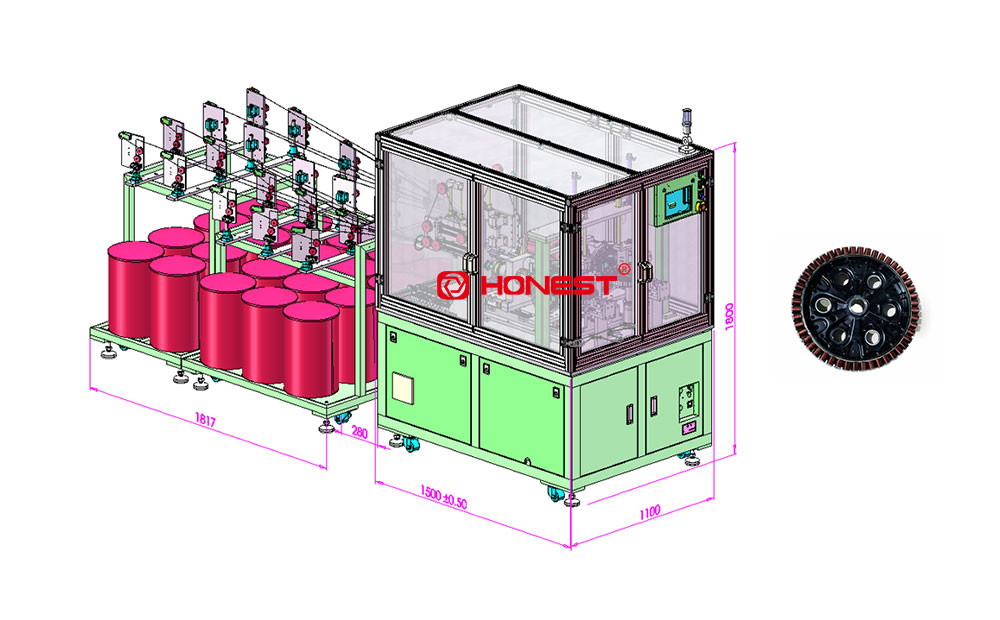In the fast-paced world of motor manufacturing, precision, speed, and reliability are essential. Whether for electric vehicles, industrial machinery, or consumer appliances, motors play a vital role in our modern lives. At the heart of these motors lies the stator—the stationary part of the motor that houses the coils. The efficiency and durability of a motor largely depend on how accurately and consistently the stator windings are applied. That’s where an automatic stator winding machine and a motor stator winding machine come into play.
These advanced machines have revolutionized stator production by automating the winding process, ensuring perfect alignment, uniform tension, and minimal errors. This article explores the benefits, working principles, applications, and future trends of these machines in the electric motor manufacturing industry.
Understanding the Stator and Its Importance
What Is a Stator?
The stator is the static part of an electric motor, comprising laminated iron cores and copper or aluminum windings. It generates a rotating magnetic field when electrical current passes through the windings, which interacts with the rotor to produce motion. The quality and configuration of stator windings directly influence the motor’s performance, efficiency, and operational life.
Challenges of Manual Winding
Before automation, stator winding was largely a manual or semi-automatic process. Manual winding is time-consuming and prone to inconsistencies in tension and positioning. Errors during this stage can result in overheating, increased vibration, or early failure of the motor.
With the demand for compact, high-efficiency motors, manufacturers required a better solution — thus, the rise of automatic and motor stator winding machines.
What Is an Automatic Stator Winding Machine?
Overview and Function
An automatic stator winding machine is a sophisticated piece of equipment designed to wind wire coils onto the stator slots with high precision and speed. Controlled by advanced software, these machines automate the process of coil layering, cutting, shaping, and inserting the wire into the stator core.
Key Components
- Wire Feeding System: Automatically supplies wire from the spool to the winding head.
- Winding Head: Executes precise rotations and placement of wire around the stator slots.
- Tension Control: Maintains consistent wire tension to prevent stretching or slack.
- Cutting Unit: Automatically cuts the wire at the end of each coil.
- Control Panel: Offers digital programming of coil turns, dimensions, and winding patterns.
Benefits of Automation
- Consistency: Each coil is wound to exact specifications.
- Speed: Machines operate much faster than human hands.
- Labor Reduction: Less need for manual labor or skilled operators.
- Reduced Errors: Eliminates human error and wire damage.
- Data Tracking: Monitors each winding cycle for traceability and quality assurance.
Exploring Motor Stator Winding Machines
Role in Motor Manufacturing
A motor stator winding machine is a type of equipment specifically engineered for winding the stators of electric motors. It is used across various industries where electric motors are essential. These machines are capable of handling different stator sizes, wire gauges, and winding techniques.
Features of Motor Stator Winding Machines
- Multiple Spindle Designs: Allows simultaneous winding of multiple stators.
- Programmable Controls: Customizable settings for various motor models.
- High-Speed Motors: Ensures faster completion of each winding task.
- Automatic Indexing: Moves the stator automatically during the winding process.
- Integrated Inspection: Checks for short circuits, open coils, and insulation faults.
Types of Winding Supported
- Single Layer Winding
- Double Layer Winding
- Needle Winding
- Wave Winding
- Flyer Winding
Advantages of Using These Machines
Increased Efficiency
Automatic and motor stator winding machine significantly reduce cycle times. Where manual winding may take several minutes for one stator, automated machines can produce several in the same period.
High Precision
Precision is vital for minimizing resistance and maximizing motor performance. These machines deliver exact coil turns and spacing, leading to optimal magnetic field generation.
Scalability
As demand increases, manufacturers can scale up production without compromising on quality. Machines can run continuously with minimal maintenance and consistent output.
Cost Savings
While initial investment in equipment may be high, the long-term operational savings are substantial. Fewer defects, lower scrap rates, and less reliance on skilled manual labor reduce overall production costs.
Enhanced Product Quality
Uniform windings result in quieter motors, less vibration, and improved energy efficiency. This is especially important in industries like automotive, aerospace, and renewable energy.
Applications in Various Industries
Automotive Sector
Electric vehicles (EVs) require high-performance motors that are compact and efficient. Automated winding machines ensure reliable coil placement and better thermal management, crucial for EVs.
Home Appliances
Appliances like washing machines, air conditioners, and refrigerators use motors that must operate quietly and efficiently. These machines ensure high-quality motor stators that meet industry standards.
Industrial Equipment
Motors used in conveyor belts, pumps, and robotics must run continuously. Automatic winding machines deliver motors that can withstand rigorous industrial use.
Renewable Energy
Wind turbines and solar tracking systems rely on electric motors for movement. These motors require durable, precisely wound stators that can withstand environmental stress.
How These Machines Work
Step-by-Step Winding Process
- Program Input: Operator inputs stator specs such as wire diameter, number of turns, and winding pattern.
- Stator Loading: The machine loads the stator onto the rotating spindle or winding fixture.
- Wire Feeding: The wire is guided from the spool to the winding head.
- Winding: The wire is wound into the stator slots as per programmed pattern.
- Cutting and Sealing: Once winding is complete, the wire is cut and sealed or taped.
- Unloading: The wound stator is removed and replaced with a new core.
Safety and Quality Control
Modern machines are equipped with sensors to detect wire tension, breakage, and alignment issues. They also conduct basic electrical tests to confirm continuity and insulation integrity.
Common Customizations
Modular Designs
Machines can be tailored to fit different stator sizes, from small fan motors to large industrial drives.
Multi-Spindle Setup
In high-volume environments, multi-spindle configurations enable simultaneous winding of several stators, increasing productivity.
Servo-Controlled Motion
Servo motors offer high-precision control over winding movements, essential for compact or complex coil geometries.
Remote Monitoring
Advanced models support IoT-based remote diagnostics and maintenance alerts, reducing downtime and improving service life.
Maintenance and Longevity
Routine Checks
Regular maintenance ensures machines operate at peak performance. This includes:
- Checking tensioners and guides
- Cleaning wire paths
- Lubricating moving parts
- Updating software
Training and Operation
While the machines are largely automatic, proper training is essential for operators to troubleshoot errors, perform maintenance, and ensure safety protocols are followed.
Future Trends in Stator Winding Technology
AI-Driven Optimization
Artificial intelligence will enable machines to self-adjust parameters in real time based on material properties and environmental conditions.
Eco-Friendly Manufacturing
Manufacturers are increasingly focused on sustainable practices. These machines help by reducing material waste, energy consumption, and ensuring recyclable outputs.
Miniaturization
With the rise of micro-motors in medical and electronic devices, manufacturers are developing compact winding machines capable of ultra-fine precision.
Integration with Digital Factories
Automatic winding machines are becoming part of interconnected smart factories, enabling real-time data exchange, production tracking, and predictive maintenance.
Conclusion
The integration of the automatic stator winding machine and motor stator winding machine into motor production has dramatically improved the reliability, efficiency, and scalability of stator manufacturing. These machines offer unmatched benefits in terms of precision, productivity, and cost-effectiveness.
From small appliances to advanced electric vehicles, the motors that power modern life are only as good as the winding within their stators. By leveraging automation and smart technologies, manufacturers can meet rising global demands while maintaining superior product quality.
As innovations continue to reshape manufacturing, these machines will remain at the core of efficient, sustainable, and high-performance motor production.





























